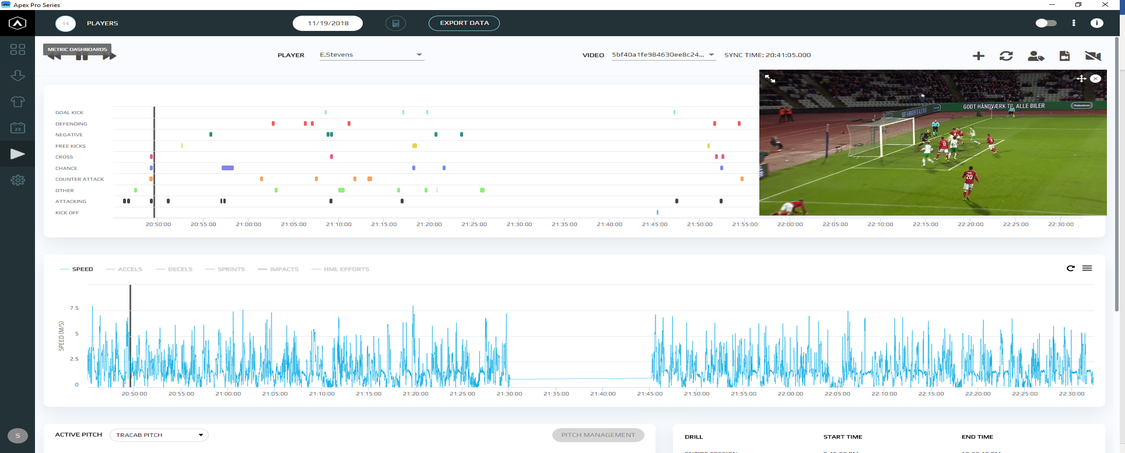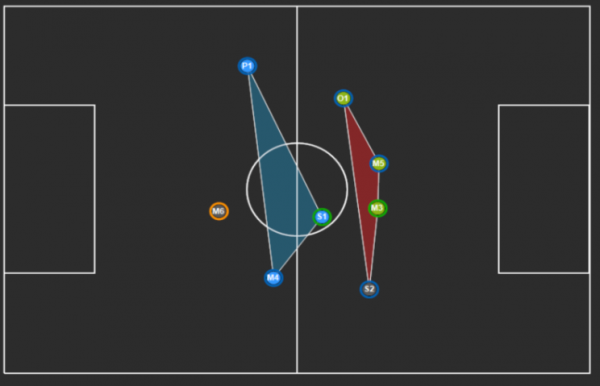
25 Jul Creating the Bigger Picture: Integrating Video and Time-Motion Data
Introduction
The use of GPS wearables has become commonplace amongst elite, and even amateur sporting organisations over the last decade.
Time-motion data has provided critical insight into the physical demands of numerous field sports, allowing researchers and practitioners to achieve a comprehensive understanding of game demands [1].
This information can subsequently be applied by practitioners within the elite sport sector to closely monitor and structure training loads, such that athletes are suitably prepared for competition.
An important process in the collection of time-motion data is the creation of Drills. Drills allow practitioners to identify timepoints of interest within a performance, such as a specific training modality or a phase of play in competition and assess the physical outputs during these Drills in isolation, further contextualising the physical output.
Perhaps an underutilised technique in time-motion analysis is the integration of tactical and technical data.
Tactical and technical data are typically collected within in applied settings by a dedicated performance analyst within the organisation, using video analysis softwares.
Analysis will typically consist of a series of statistical performance measures, such as percentage pass completion, and may also be accompanied by the tactical purpose (e.g. pressing) of a player movement [2].
A stronger integration between sport scientists and performance analysts has great potential for; 1). in a research setting to greatly improve the understanding of how tactical and technical actions influence physical outputs, and 2). in an applied setting, allow practitioners to improve drill creation to replicate match demands, encompassing the tactical and technical elements in addition to physical metrics, while possibly using physical measures tactical contexts to create new performance measures, e.g. Pressing Efficiency.
Analysis Techniques
Within the STATSports Sonra, Apex and Viper software packages there are two features which can aid practitioners in integrating video analysis and time-motion analysis; the Session Replay feature, and XML Export function for third party video softwares.
Both methods provide practitioners with a range of analysis techniques to gain a deeper understanding of performance, allowing for tactical, technical and biomechanical analysis.
Session Replay
The Session Replay feature uses positional data from the Apex device and the pitch location to create a 2D re-animation of a session.
This graphical recreation allows the user to track player positioning throughout a session, while using adjoining video provides greater context to the mapping, such as ball and opposition position.
The ability to draw links between players is a highly valuable tactical tool as it allows a coach to track the distance between different positional groups, such as the back four in soccer.
This is particularly useful when tracking player positioning while the player(s) in question are out of camera view.
Furthermore, player icons can be customised to different colours, allowing users to create easily visible player groups, with practical applications in small sided games or tactical analysis of training session data.

Figure 1. Example of a Session Replay, with defenders highlighted in red, midfielders in blue.
XML Exports
The XML Export feature in the STATSports Apex software allows the user to create an XML file of ‘Event Tags’, including; Impacts, Sprints, Accelerations, Decelerations, HML Efforts, High Intensity Bursts and Collisions (Rugby versions only).
These event tags contain the timestamps of the relevant physical action and can be imported into the timeline of a video analysis platform, allowing the user to analyse clips corresponding to the selected STATSports metrics.
This is a highly useful feature as it allows for the physical metrics to engage with the tactical and technical tags which are typically coded within video platforms. This provides a greater layer of context by illustrating the tactical purpose of a high-intensity movement.
For example, a soccer coach may be interested in viewing all sprints performed by a wingback that resulted in an overlap.
Furthermore, this could aid drill design, by structuring physical drills in accordance with the technical and tactical actions required during match play [3].
It is also worth noting that several video analysis softwares include biomechanical analysis tools. This could be of further interest to practitioners, as the Event Tags could be used to carry out a biomechanical analysis of the highlighted actions, which may have applications in return to play strategies.
Practical Considerations
As is always the case in a high-performance environment, the practical viability of any analysis technique should first be considered before implementation.
To integrate video and time-motion data, there needs to a certain level of buy-in between performance staff and coaches, with a shared goal in mind.
When trying to introduce a new analysis technique, timing is key. Testing such features during the off-season or pre-season is preferable as to not interfere with the in-season process.
References
- Di Salvo, V., Gregson, W., Atkinson, G., Tordoff, P., and Drust, B. (2009). Analysis of high intensity activity in Premier League soccer. International Journal of Sports Medicine, 30, (3), 205 – 212.
- Stein, M., Janetzko, H., Lamprecht, A., Breitkreutz, T., Zimmermann, P., Goldlucke, B. and Schreck, T. (2018). Bring it to the pitch: Combining video and movement data to enhance team sport analysis. IEEE Transactions on Visualization and Computer Graphics, 24, (1), 13 – 22.
- Ade, J.D., Fitzpatrick, J. and Bradley, P.S. (2016). High-intensity efforts in elite soccer matches and associated movement patterns, technical skills and tactical actions. Information for position-specific training drills. Journal of Sports Sciences, 34, (24), 2205 – 2214.
Author Details
David McKenny
Sport Scientist l Sport Science Dept.